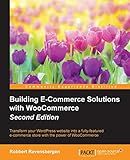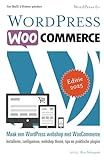Best CSS Customization Tools for WooCommerce to Buy in December 2025

The Ultimate WordPress & WooCommerce Handbook: From Setup to Success in Online Selling



Building E-Commerce Solutions with WooCommerce - Second Edition



WordPress WooCommerce: Webshop met WooCommerce (Dutch Edition)



WordPress WooCommerce: Tienda online con WooCommerce (Spanish Edition)



Formation Woocommerce: Créer et exploiter une boutique en ligne (French Edition)



Setting Up and Running an Online Store


To add custom CSS in WooCommerce, you can use the built-in customizer tool or add it directly to your theme's stylesheet. Alternatively, you can use a plugin like Custom CSS that allows you to add custom styles without affecting the theme files. To add custom CSS via the customizer tool, go to Appearance > Customize > Additional CSS and paste your CSS code there. If you prefer to add custom CSS directly to your theme's style sheet, access your theme files via the WordPress editor or FTP and locate the stylesheet file (usually named style.css). Once you have accessed the stylesheet file, add your custom CSS code at the bottom of the file. Remember to save your changes and clear your browser cache to see the custom styles reflected on your WooCommerce site.
How to use CSS selectors to style different elements in WooCommerce?
To style different elements in WooCommerce using CSS selectors, you can follow these steps:
- Inspect the element you want to style: Right-click on the element you want to style and select "Inspect" from the context menu. This will open the browser's developer tools and show you the HTML code for the selected element.
- Identify the CSS class or ID of the element: In the developer tools, look for the CSS class or ID of the element you want to style. It will be listed in the HTML code with a "class" or "id" attribute.
- Write your CSS code: Write your CSS code to style the element based on its class or ID. For example, if the element has a class of "product-title", you can write the following CSS code to style it:
.product-title { font-weight: bold; color: blue; }
- Add your CSS code to your theme's stylesheet: Once you have written your CSS code, you can add it to your theme's stylesheet. This can usually be done by going to Appearance > Customize > Additional CSS in the WordPress dashboard and pasting your CSS code there.
- Preview your changes: After adding your CSS code, make sure to preview your changes on your WooCommerce site to see how the styled element looks.
By following these steps, you can easily style different elements in WooCommerce using CSS selectors.
How to create a child theme for WooCommerce?
To create a child theme for WooCommerce, follow these steps:
- Create a new folder in your themes directory (typically located at wp-content/themes) and name it something like 'woocommerce-child-theme'.
- Inside this new folder, create a new file named 'style.css' and add the following code to define the basic information of your child theme:
/* Theme Name: WooCommerce Child Theme Template: your-woocommerce-theme-folder */
Replace 'your-woocommerce-theme-folder' with the name of the parent WooCommerce theme you are using.
- Create a new file named 'functions.php' inside the child theme folder. In this file, you can add custom functions and modifications to override the WooCommerce parent theme.
- To activate the child theme, go to your WordPress dashboard and navigate to Appearance > Themes. You should see your child theme listed there. Activate it to start using your custom child theme.
- You can now start customizing your child theme by adding custom CSS styles or modifying template files. Remember to only make changes in the child theme to avoid losing them during theme updates.
By following these steps, you can easily create a child theme for WooCommerce and make customizations without altering the parent theme files directly.
How to change the font size with custom CSS in WooCommerce?
To change the font size with custom CSS in WooCommerce, you can follow these steps:
- Log in to your WordPress dashboard and navigate to Appearance > Customize.
- In the Customizer, go to Additional CSS.
- Add the following CSS code to change the font size:
/* Change font size for all WooCommerce product titles */ .woocommerce-loop-product__title { font-size: 18px; }
/* Change font size for WooCommerce product description */ .woocommerce-product-details__short-description { font-size: 14px; }
/* Change font size for WooCommerce product price */ .woocommerce-Price-amount { font-size: 16px; }
- Adjust the font size values in pixels (px) according to your preference.
- Click on the "Publish" button to save the changes.
After adding the custom CSS code, the font size for WooCommerce product titles, descriptions, and prices should be updated according to the values specified in the code. You can further customize the font size for other elements by targeting their specific CSS classes in a similar manner.
What is the process for adding custom CSS to a specific page in WooCommerce?
To add custom CSS to a specific page in WooCommerce, follow these steps:
- Identify the specific page or product page where you want to add custom CSS.
- Go to your WordPress dashboard and navigate to Appearance > Customize.
- In the Customizer, click on Additional CSS.
- Add your custom CSS code in the text area provided.
- Use the WordPress body class to target the specific page or product page. For example, if you want to target a specific product page, you can use the ".single-product" class followed by the product ID.
- Preview your changes to see if the custom CSS is applied correctly to the specific page.
- Once you are satisfied with the changes, click Publish to save your custom CSS code.
Alternatively, you can also add custom CSS to a specific page using a plugin like Simple Custom CSS and JS. Install and activate the plugin, then navigate to the specific page or product page where you want to add custom CSS. In the page editor, you will see a Custom CSS and JS tab where you can add your custom CSS code for that specific page. Save your changes and preview the page to see the custom CSS applied.
What is the best way to test custom CSS changes in WooCommerce?
The best way to test custom CSS changes in WooCommerce is to use a development or staging site. This allows you to make changes to your CSS code without affecting your live site.
Here are the steps to test custom CSS changes in WooCommerce:
- Set up a development or staging site: Create a duplicate of your live WooCommerce site where you can test your CSS changes without affecting your live site.
- Use a child theme: Create a child theme for your WooCommerce site to ensure that your custom CSS changes are not overwritten when you update your theme.
- Use the built-in Customizer: WooCommerce comes with a built-in Customizer tool that allows you to preview and test your CSS changes in real-time. You can access the Customizer by going to Appearance > Customize in your WordPress dashboard.
- Use a CSS plugin: You can use a CSS plugin like Simple Custom CSS and JS to add your custom CSS code to your site. This allows you to easily make changes and see the effects in real-time.
- Test on different devices and browsers: Make sure to test your custom CSS changes on different devices and browsers to ensure that your site looks good and functions properly for all users.
- Troubleshoot and debug: If you encounter any issues with your custom CSS changes, use the browser's developer tools to inspect the elements and identify the problem. You can then make adjustments to your CSS code to fix any issues.
By following these steps, you can effectively test and implement custom CSS changes in WooCommerce without risking your live site.
